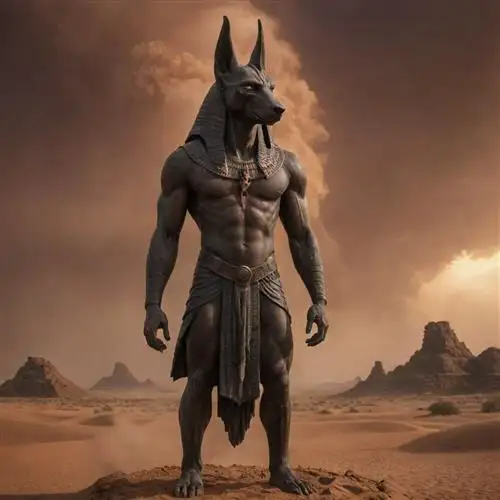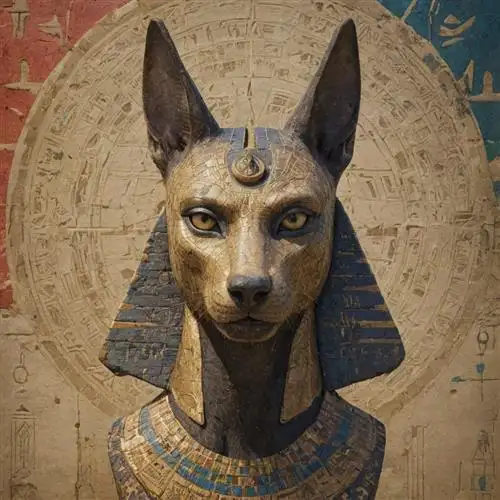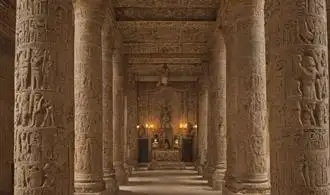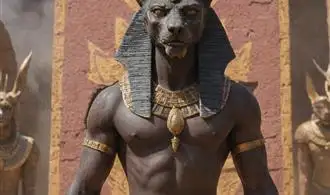Anubis, the enigmatic jackal-headed deity, has long captivated the fascination of scholars and enthusiasts alike. His origins, shrouded in the mists of ancient Egyptian mythology, have been the subject of extensive research and debate. Delving into the rich tapestry of Anubis' beginnings, we uncover a complex and multifaceted history that sheds light on the pivotal role this deity played in the ancient Egyptian pantheon.
One of the earliest known references to Anubis dates back to the First Dynasty, around 3100 BCE. During this formative period, Anubis was already firmly established as the god of embalming and the protector of the dead, a role that would only grow in significance over time. However, the origins of this powerful deity extend even further back, with some scholars tracing his roots to pre-dynastic Egyptian beliefs and practices.
The name "Anubis" itself is derived from the ancient Egyptian word "inpu," which translates to "to decay." This etymological connection suggests Anubis' primordial association with the processes of death and decomposition, a fundamental aspect of the ancient Egyptian understanding of the afterlife. As the god responsible for guiding the deceased through the perilous journey to the afterlife, Anubis became a central figure in the elaborate funerary rituals and beliefs that permeated Egyptian society.
Intriguingly, the jackal-headed form of Anubis may have stemmed from the ancient Egyptians' reverence for the wild canine species that inhabited the deserts and necropolis regions. These scavengers, often associated with the liminal spaces between the world of the living and the dead, were seen as embodiments of Anubis' dual nature as both a protector and a harbinger of the transition to the afterlife.
The multifaceted nature of Anubis' origins is further highlighted by his connections to other deities within the Egyptian pantheon. Some scholars argue that Anubis may have originated as a local or regional deity, who later became absorbed into the broader religious framework as the ancient Egyptian civilization evolved. His association with the god Wepwawet, another jackal-headed deity, suggests a complex interplay of mythological narratives and the amalgamation of various regional traditions.
Anubis, the powerful Egyptian god, was revered as the guardian of the dead and the protector of the deceased's journey to the afterlife. As one of the most significant deities in the ancient Egyptian pantheon, Anubis played a vital role in the rituals and beliefs surrounding death and the transition to the next life.
At the heart of Anubis' role as the guardian of the dead was his responsibility to oversee the process of mummification and the preservation of the dead body. The ancient Egyptians believed that the preservation of the physical form was essential for the soul to continue its journey after death. Anubis, with his jackal-like head and black canine appearance, was believed to be the deity who presided over this sacred ritual, ensuring the proper preparation of the deceased for their final resting place.
Beyond the mummification process, Anubis was also responsible for guiding the deceased's soul through the treacherous journey to the afterlife. In the famous weighing of the heart ceremony, Anubis would stand by as the deceased's heart was weighed against the feather of truth, determining their worthiness to enter the realm of the dead. If the heart was found to be pure and righteous, the soul would be allowed to continue on to the next life. Anubis' presence during this critical moment ensured the fairness and impartiality of the judgment, further solidifying his role as the guardian of the dead.
The importance of Anubis in ancient Egyptian beliefs was also reflected in the prominent placement of his statues and representations within tombs and funerary sites. Statues of Anubis were often positioned at the entrance of the tomb, serving as a guardian and protector of the deceased's final resting place. Additionally, Anubis was depicted in various funerary texts and rituals, further emphasizing his central role in the afterlife journey.
Anubis, the ancient Egyptian deity, is a figure of immense significance and symbolism within the rich tapestry of Egyptian mythology. Often depicted with the head of a jackal or wild dog, Anubis was revered as the god of the underworld, mummification, and the afterlife. His role in the Egyptian pantheon extends far beyond the conventional perception of a mere death deity, delving deep into the realms of symbolism and spiritual significance.
The symbolism of Anubis is multifaceted and complex, offering insights into the ancient Egyptians' understanding of the afterlife and the transition from mortal existence to the realm of the divine. As the guardian of the dead, Anubis was responsible for the embalming process, ensuring the proper preparation of the deceased for their journey into the afterlife. This responsibility made Anubis a crucial figure in the Egyptian funerary rituals, as he guided the souls of the departed through the treacherous landscapes of the underworld.
The jackal-headed visage of Anubis is a powerful symbol in itself, representing his connection to the natural world and the cycle of life and death. Jackals were often observed near gravesites, scavenging the remains of the deceased, and this association led the ancient Egyptians to view Anubis as a sentinel of the necropolis, guarding the tombs and ensuring the proper transition of the soul.
Beyond his role as the embalmer and protector of the dead, Anubis was also believed to weigh the hearts of the deceased during the process of judgment in the afterlife. This ritual, known as the "Weighing of the Heart," was a pivotal moment in the Egyptian concept of the afterlife, where the soul's purity and worthiness were determined. Anubis, with his discerning gaze and sacred scales, played a central role in this process, ensuring the souls of the departed were granted the opportunity to join the divine realm.
The significance of Anubis extends even further, as he was also associated with the complex and multifaceted concept of maat, the ancient Egyptian principle of order, balance, and justice. As the guardian of the underworld and the arbiter of the dead, Anubis was seen as a embodiment of this vital cosmic principle, upholding the delicate equilibrium between the mortal and divine realms.
While Anubis may have originated in ancient Egyptian mythology, his influence has transcended the boundaries of history, making a significant impact on modern popular culture. This powerful deity, known as the god of the dead, the embalmer, and the guide to the underworld, has captivated the imagination of artists, writers, and enthusiasts alike, breathing new life into the rich tapestry of Egyptian mythology.
One of the most striking examples of Anubis' presence in modern pop culture can be found within the realm of comic books and graphic novels. The character of Anubis has appeared in numerous Marvel and DC Comics, often serving as a formidable antagonist or a mysterious ally to the protagonists. In the Marvel universe, Anubis has been featured in titles such as "X-Men: Age of Apocalypse" and "Thor: God of Thunder," showcasing his imposing stature and the enigmatic nature of his powers.
Moving beyond the comic book medium, Anubis has also found a prominent place in popular video games. In the Assassin's Creed franchise, the god Anubis plays a crucial role, serving as a guardian of the underworld and a source of both guidance and challenge for the player. This integration of Anubis into the game's narrative and gameplay mechanics has helped to elevate the deity's prominence and spark the interest of a new generation of fans.
The allure of Anubis has also extended to the world of literature, with the Egyptian god appearing in numerous novels and short stories. From Neil Gaiman's "American Gods" to Rick Riordan's "Kane Chronicles" series, Anubis has been portrayed as a complex and multifaceted character, often serving as a guide or a source of wisdom for the protagonists. These literary depictions have helped to expand the mythology surrounding Anubis and explore the deeper significance of his role in the afterlife.
In the realm of film and television, Anubis has made notable appearances as well. The character has been featured in various historical dramas, documentaries, and even science fiction productions, showcasing the versatility of the deity's narrative potential. These visual interpretations have helped to bring the ancient Egyptian god to life, captivating audiences with his imposing presence and the mystique surrounding his role in the afterlife.
Beyond the realms of popular media, Anubis has also found a place in the world of fashion and design. The iconic jackal-headed figure has been featured on clothing, jewelry, and various home decor items, reflecting the enduring fascination with ancient Egyptian culture. This integration of Anubis into modern consumer goods has helped to maintain the deity's relevance and accessibility to a wider audience.
















